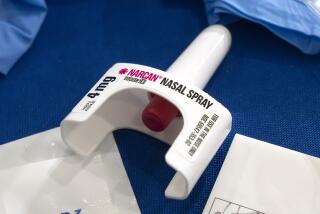S.D. to Get Device That Shatters Kidney Stones
- Share via
Relief from kidney stones and the excruciating pain they cause may soon be no more than a bath away for many San Diego residents.
A West German-made machine known as the “stonecracker” will be installed at the UC San Diego Medical Center early next year. Approved for use in the United States last year by federal authorities, the machine has been called the most innovative technology ever developed for urology treatments. The $2-million device will be the first to serve stone sufferers in San Diego and Imperial counties who otherwise would have to undergo lengthier and more painful conventional surgery to remove their stones.
The machine works by generating high-pressure shock waves that are focused onto a patient’s kidney stones through a water bath in which the patient sits. The shock waves shatter the stones, similar to the way windows break when a high-speed airplane sends a sonic boom to the ground or when the sound waves from an opera singer’s high notes shatter a glass. The pulverized granules are then passed normally through the urinary system.
“It is capable of treating the (kidney stone) problems of between 80% and 90% of persons with stones,” said Dr. Christian G. Chaussy, professor of urology at UCLA Medical Center who helped develop the machine during the 1970s at the University of Munich. The West German doctor spoke at UCSD last weekend on the preparations necessary for beginning shock wave therapy. UCLA was one of the first U.S. hospitals to have the device and is now a training center for physicians wanting to use the technique in other regions.
In order to share the expense of the machine--known officially as a lithotriper (Greek for “stonecracker”)--it will be operated jointly by UCSD and a group of 29 urologists in private practice countywide.
Kidney stones affect approximately 12% of all Americans, usually between 20 and 40 years of age. Almost 300,000 people are hospitalized annually, and about half of them require surgery.
While the precise causes of kidney stones are not known, a variety of factors--including diet, genetics, geography and occupation--are suspected of playing roles. Doctors say that 75% of all stones consist of calcium deposits.
The stones, usually consisting of calcium deposits, form in the kidney or upper urinary tract, developing first to the size of a small grain and occasionally growing to an inch or more in diameter. Most stones remain tiny and are passed without problems, but those that do grow require surgery, usually a two-hour operation involving a five- to eight-inch incision that may take two months to heal fully.
The West German medical technique developed from industrial experiments during the early 1970s on the effect of shock waves on supersonic aircraft wings, according to Chaussy. In 1973, the West German government authorized a research grant for the University of Munich to explore the possibilities of using shock waves on biological tissue.
The machine was first used clinically in West Germany in 1980, and 60,000 to 70,000 treatments are now performed each year in Europe, Chaussy said. After approval from the U.S. Food and Drug Administration, the machine has been placed at 40 hospitals around the nation in the last year. There are three machines in Los Angeles and Orange counties.
The key benefit of the “stonecracker” is that it requires no incision to remove the stones. The patient is partially anesthetized, strapped into a gantry, then lowered into a stainless steel tub. An electrode at the tub’s bottom discharges an electric current, creating an underwater spark that generates a pressure wave.
Two X-ray monitors next to the patient allow doctors to make certain that the electrode is positioned properly so that the shock waves focus on the kidney stones. The waves are generated in groups of 100, and a one-inch stone would require 1,500 to 2,000 waves before it is broken down.
Once the procedure is completed, usually within an hour, the patient remains in the hospital for two or three days to make certain that the stone has disintegrated and is being passed. Most patients are able to resume normal activities after that time, although a month may pass before all grain-size fragments leave the body.
Chaussy and Dr. Joseph Schmidt, head of urology at UCSD Medical Center, cautioned that persons with certain stones, particularly those who have particularly hard stones or whose stones are lodged within the urethra, are not candidates for the non-surgical procedure.





